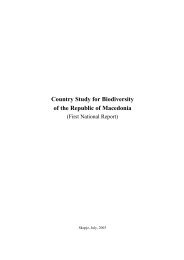CBD Fourth National Report - Azerbaijan (English version)
CBD Fourth National Report - Azerbaijan (English version)
CBD Fourth National Report - Azerbaijan (English version)
You also want an ePaper? Increase the reach of your titles
YUMPU automatically turns print PDFs into web optimized ePapers that Google loves.
Country Study on Biodiversity and <strong>Fourth</strong> <strong>National</strong> <strong>Report</strong><br />
The Republic of <strong>Azerbaijan</strong><br />
dance, and in the history of architecture, and much of this folklore is related to the natural<br />
resources of the region and reflect the close relationship between culture and natural history.<br />
The culture is globally renowned for its cultural and spiritual achievements. Ancient customs<br />
and traditions remain significant in the spiritual lives of modern Azeris. Families have played<br />
a central role in maintaining these traditions through the generations. Religious events are<br />
celebrated as national holidays, such as ‘Gurban Bayrami’ (the day of the sacrificial slaughter<br />
of an animal). The 21st of March (the equinox) is ‘Novruz Bayramy’, a celebration of the<br />
coming spring. Rural communities also celebrate the harvest on ‘Harvest holiday’. For all<br />
these celebrations Azeris prepare food as gifts for friends and relatives.<br />
<strong>National</strong> crafts reflect the rich biological resources of the country. The main crafts are<br />
carpets, silks, jewellery, and wood, stone and metal carvings. The internationally renowned<br />
carpet makers are found in Guba, Shamakhi, Ganja, Gazakh, Garabach, and the villages<br />
around Baku. Carpets traditionally are made using plant dyes and wool.<br />
Azeri literature depicts the many ancient traditions of the country, and many great authors<br />
(such as Khagani, Nizami, Fizuli, Nazimi, Vagif, Sabir, Jalil Mammadguluzadeh, and<br />
Husseyn Javid) reveal the close relationship between the culture of the region and its<br />
biodiversity.<br />
3.1.5.3. Spiritual values of biodiversity<br />
One of the unique aspects of Azeri culture is the variety of religions that are currently and<br />
historically practiced (see Chapter 2). Many religions teach the importance of biodiversity. In<br />
particular, islamic religion worhipped by <strong>Azerbaijan</strong> nation emphasizes advocating of nature<br />
care and affection in sacred and holy Koran (even some of suras are titled with names of<br />
animals - bee, cow and etc.).<br />
3.1.5.4. Recreation and biodiversity<br />
Due to the need to house more than one million refugees in <strong>Azerbaijan</strong>, there is great pressure<br />
on recreation sites. The areas traditionally used for recreation and spas are now used for<br />
sheltering these people. Of the 12,000 tourist sites, 10,000 are occupied by refugees - despite<br />
the fact that these sites are unsuitable as permanent settlements.<br />
The main areas used for tourism and spa use are within the Absheron, Nabran, Kura, and<br />
Lenkoran coastal resorts, and tourists visit such resorts over five months of the year. Changes<br />
in the level of the Caspian Sea have caused a great number of recreational centres on the coast<br />
to be flooded. Other areas in the forested mountain regions of Guba, Shemakha-Ismailli,<br />
Belokan-Gabala, Kelbajar, Karabakj, Kedabek, Nakhichevan and Ganja-Naftalan are visited<br />
because of the presence of thermal springs and medicinal mud volcanoes. Over 300<br />
recreational sites have been identified in these regions, within a total area of 35,000 ha (much<br />
of which is forested).<br />
Establishment of initial <strong>National</strong> Parks in <strong>Azerbaijan</strong> in 2003 - i.e. Ordubad <strong>National</strong> Parks<br />
named after H.Aliyev, Shirvan and Aghgol <strong>National</strong> Parks, then organization of Hirkan and<br />
Altiaghaj <strong>National</strong> Parks in 2004, Absheron <strong>National</strong> Park in 2005, Shahdagh <strong>National</strong> Park<br />
in 2006, Goygol <strong>National</strong> Park in 2008 as continuance of regular actions carried out on this<br />
purpose, created a favorable condition for arrangement of ecotourism activity in natural areas<br />
where rich historical monuments, unique landscape, geological and climate features and<br />
various biodiversity exist.<br />
80<br />
2009

















